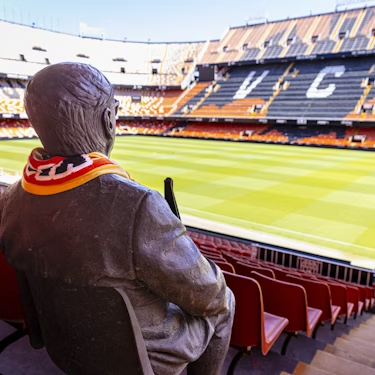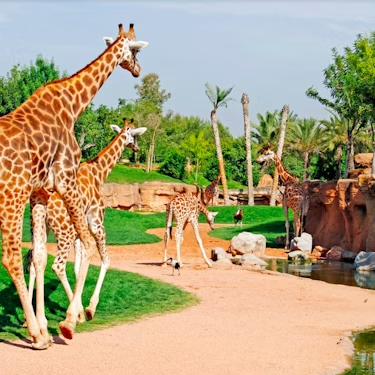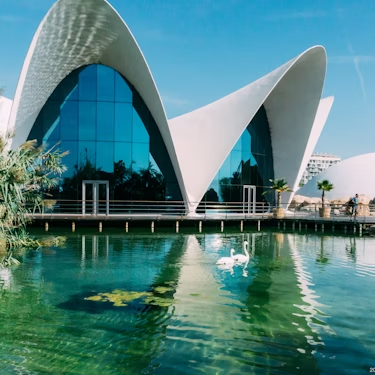More about: Valencia in 3 Days: a guidebook for getting the most out of your visit
Valencia, a city that combines a wealth of culture with a modern and avant-garde atmosphere, kilometres of fantastic beaches and exquisite gastronomy. All this makes it one of the most complete and interesting cities to visit in Spain.
Ranked number three of the country' s largest cities, Valencia is also known for its lively life and, of course, for its most famous dish: paella. In this itinerary I'm going to help you organise a three-day trip to this wonderful destination so that you know everything there is to see and do in Valencia and don't miss out on anything.
1. Day one: explore the historic centre of Valencia and visit a very special museum

To start your first day in the port city of Valencia, you will begin by getting to know its historic centre and the wonderful monumental buildings that are found there.
After a tour of its most emblematic buildings, you will have the opportunity to visit its famous Central Market, where you will try some of the area's traditional foods.
In the afternoon, after walking around the centre of this beautiful city a little more, you will enter its most special museum: The Gonzalo Martí National Museum of Ceramics and Sumptuary Arts. And to end this full day, you will go to the Ruzafa neighbourhood, one of the liveliest areas where you can have dinner and, if you feel like it, end the night with a drink in one of its many pubs.
Start your day in the Plaza de la Virgen
The first stop on your itinerary today is the centrally located Plaza de la Virgen. This monumental square is located in what was once the city's Roman forum and inside it houses the Basilica of the Virgen de los Desamparados, the Palace of the Generalitat Valenciana and the Valencia Cathedral.
In addition, in the centre of the square is a magnificent fountain designed by sculptor Manuel Silvestre Montesinos in 1976 and representing an allegory of the Turia River. Due to the beauty of this place, I recommend you have a coffee in one of its bars to contemplate it in peace and quiet.
Next, you will make your first visit of the day by entering the Cathedral of the Holy Chalice, whose predominant style is Valencian Gothic.
The entrance includes a visit to the cathedral museum and, although you have to pay a separate entrance fee to climb the Miguelete bell tower, I encourage you to do so, as the entrance fee is quite cheap and you won't regret it when you see the fantastic views of the city. Another equally good option would be to book a tour of the centre of Valencia, which includes entrance to the cathedral and other important monuments.
Continue the tour with the Basilica de la Virgen de los Desamparados
After visiting the Valencia Cathedral and climbing its high tower, your next stop on the route is the Basilica of the Virgen de los Desamparados, which is right next to it.
This temple, whose style is halfway between Renaissance and Baroque, is dedicated to the Virgen de los Desamparados, the patron saint of the city. In fact, inside you will find a museum dedicated entirely to her, ranging from paintings to sculptures and ceramics. One of the most outstanding features of the basilica is its enormous dome, which is covered with frescoes and is considered to be the jewel of the church.
- Where: Plaza de la Virgen, 6.
- Opening hours: Monday to Sunday from 7.30am to 2pm and from 4.30pm to 9pm.
- Price: General admission to enter the basilica is approximately €4, but if you give the entrance ticket to the cathedral the price is reduced.
Follow your way to the Church of San Nicolás and the Silk Exchange
Continuing along the proposed route, the next two places to visit are the Church of San Nicolas and the Silk Exchange. Both are less than 5 minutes walk from the previous destinations.
The Church of San Nicolás de Bari and San Pedro Mártir has the honour of being called the Valencian Sistine Chapel due to the impressive pictorial work it houses inside.
As for La Lonja de la Seda, it is an imposing Gothic building whose beauty and cultural importance have led it to form part of the list of World Heritage Sites.
If, on the other hand, you prefer to do your tour of Valencia with an expert guide, you can check out the best tours in Valencia and book one to make sure you don't miss any detail of this magnificent city.
Enjoy Valencia's gastronomy at the Central Market
In the most central part of the city, next to the Lonja de la Seda, stands the impressive Central Market of Valencia, one of the largest fresh produce markets in Europe.
It is housed in a modernist building with a structure formed by tall iron columns of the most characteristic and covering up to 8,000 square metres of surface area. Among its 1,200 stalls you can find meat, fish, cheese, fruit, vegetables and much more. Once you're there, I encourage you to take the opportunity to eat at the Supergourmet del Mercado Restaurant, an exquisite tapas bar with great value for money. Of course, I recommend you book in advance.
Another fantastic option for lunchtime would be to book a gastronomic tour of Valencia, where you will have the opportunity to taste up to 10 different dishes.
Continue your tour to the National Museum of Ceramics
Before reaching the museum, you'll take a detour to stroll around the Plaza Redonda and the Plaza del Ayuntamiento. Both are within walking distance of the Central Market, so I encourage you to go there to get to know two of the most representative places in the city of Valencia.
When you finish your pleasant stroll, go to the National Ceramics Museum, which is located in the beautiful Palacio de Cerámica. The Palacio del Marqués de Dos Aguas, which is located in the beautiful Palacio del Marqués de Dos Aguas. This marvellous rococo-style palace houses an impressive collection of Spanish and foreign ceramics that will not leave you indifferent.
- Where: Carrer del Poeta Querol, 2.
- Opening hours: Tuesday to Saturday from 10:00 to 14:00 and from 16:00 to 20:00. Sundays from 10:00 to 14:00 h.
- Price: general admission is approximately €3.
End the day in Valencia's most alternative district
To end your first day in Valencia, I'm going to ask you to go to its coolest neighbourhood, the Ruzafa district. This area of the city was once an Arab quarter, but due to gentrification, it has become a multicultural place full of avant-garde restaurants, bookshops-cafés, art galleries and bars.
The heart of this neighbourhood is undoubtedly the Ruzafa Market, a colourful building that hides a large number of stalls and restaurants inside. Once there, you'll even have the chance to take a workshop where they'll teach you how to prepare an authentic Valencian paella with products bought at the market.
For dinner, I recommend you go to the Maui Russafa restaurant, a high-quality tapas bar at a very reasonable price. Afterwards, you can take the opportunity to have a drink in one of the nearby pubs.
2. Day two: get to know the city's most emblematic museum

For your second day, I have prepared a morning in the famous City of Arts and Sciences, an essential plan if you decide to spend your holidays in Valencia.
After tasting a delicious Valencian paella, you will stroll along one of the city's beaches until you reach the Port of Valencia. And to finish the day, you can discover a very special area of the city: the Cabanyal neighbourhood.
Get to know the impressive City of Arts and Sciences
The City of Arts and Sciences is an ideal place if you are visiting Valencia with children. However, you don't have to bring the little ones to enjoy this enormous complex for scientific and cultural dissemination.
With more than 350,000 metres of surface area, this place has been conceived as an independent city dedicated to cultural leisure and made up of six different areas for different purposes:
- The Palau de les Arts Reina Sofía, for performing arts and opera.
- The Hemisferic, a planetarium, laser and IMAX cinema projection room.
- The Umbracle, a beautiful garden in which to stroll.
- The Museu de les Ciències Príncipe Felipe, an interactive science museum.
- The Oceanografic, the largest aquarium in Europe.
- The Ágora, a space dedicated to the celebration of events.
This tour will take at least the whole morning and you can buy separate tickets for the buildings you are most interested in, together for a full tour or book a guided tour.
Try a real Valencian paella
Although it is true that most of the visits you are going to make can be done on foot, due to the fact that this part of the city is further away from the centre, I recommend that you take a bus.
To get to the restaurant where you can try the famous paella of Valencia, when you leave the City of Arts and Sciences you only have to take line 99 and get off at the La Malva-rosa - Mendizàbal stop. You can also consult the bus information on the Valencia transport website.
Located near the Malvarrosa Beach, the Casa Carmela Restaurant is a centenary gastronomic space specialised in rice dishes. There, you can enjoy a fantastic Valencian paella cooked in the traditional way. It is advisable to book in advance.
Stroll along the coast of Valencia
After an unforgettable meal in one of the most typical restaurants, I recommend that you continue your tour with a walk along the Malvarrosa Beach promenade until you reach the Port of Valencia.
If you are lucky and you travel to Valencia in summer, you can even take advantage of this walk to take a dip and cool off on the city's most famous beach. Once you get to the port, you can see all the boats that dock there, admire the Clock Building or sit down for a drink overlooking the sea.
Close your second day with a visit to the Cabanyal neighbourhood.
Just over 15 minutes' walk from the port is the picturesque Cabanyal neighbourhood. This area of the city is known for its beautiful little colourful houses with modernist touches whose facades are covered with tiles.
A curiosity about this neighbourhood is that it used to be an independent municipality called the Pueblo Nuevo del Mar (New Town of the Sea). Nowadays it belongs to the city of Valencia, but it maintains the traditional atmosphere of the fishing village it once was. Strolling through its streets is a real pleasure, so I suggest you take a leisurely stroll through them admiring its beautiful buildings.
Another outstanding feature of this small Valencian corner is its wonderful gastronomic offer. For this reason, I recommend that you take the opportunity to dine in the area. Two of the best-rated restaurants are Taberna de Anyora, a traditional tapas bar with local ingredients and organic wine, and La Sastrería, an exclusive place decorated in an exquisite seafood style and specialising in seafood.
3. Day three: bid farewell to Valencia with a visit to the lively Barrio del Carmen

For your third and last day I have prepared a tour of the city centre, starting at the Estación del Norte train station, crossing the Jardín del Turia and ending in the well-known Barrio del Carmen, passing by some of the monuments in the area.
Start the tour with the Estación del Norte and the Colón Market
To start the last day, you will visit the Estación del Norte, a railway station built in a beautiful modernist building, belonging to the "Viennese Sezession" trend and which is the work of the architect Demetrio Ribes. This enormous building is of great architectural importance and is considered one of the most representative of the city.
After this first visit you will walk approximately 10 minutes to your next point on the route, El Mercado de Colón, another imposing modernist building that has been declared a National Monument.
Composed of three large halls that form an open and luminous space, the market houses a large number of bars and restaurants with a spectacular gastronomic and drinks offer.
Although if gastronomy is one of your passions, you might want to consider booking a gastronomic tour of Valencia, where you can discover all the secrets of the local cuisine and products.
Stroll through the immense Turia Garden
After visiting the impressive Mercado de Colón, I'm going to ask you to take a short walk to the nearest entrance of the Turia Garden, a gigantic park where you can relax in nature. This garden stretches all the way to the City of Arts and Sciences and, as well as having many children's play areas, sometimes hosts fairs and concerts.
As lunchtime approaches, you can head back into the city centre to the fantastic Rincón 33 restaurant. Here, on Carrer de la Corretgeria, you can eat various types of rice, topped off with the delicious socarrat, typical of the area. However, bear in mind that if you want to try the traditional Valencian paella, you'll have to book in advance.
A quick and fun option to continue your tour of Valencia would be to rent an electric scooter with which you can get to all the corners in much less time, as well as having a great time.
Continue your journey to the Serranos Towers
After a good meal at Rincón 33, your next destination will be the Serranos Towers. However, you'll have to make a short detour first, as just 3 minutes away from the restaurant you'll find the Horchatería Santa Catalina, because you won't want to leave Valencia without trying its most famous drink.
In this horchatería, which is more than two centuries old, you can choose between tasting a homemade horchata, a Valencian water or a good homemade ice cream. After indulging yourself, it's only a 10-minute walk to the Serranos Towers.
These two medieval towers were built to defend one of the busiest entrances to the ancient city of Valencia. They also served as a triumphal arch and are now considered one of the most emblematic icons of the city.
End your last day in Valencia with a stroll through the popular Barrio del Carmen neighbourhood
This neighbourhood of millenary origin takes its name from the Church and Convent of El Carmen.
Although the Barrio del Carmen was once surrounded by a wall, today only two sets of towers remain to commemorate that era.
As well as having beautiful streets lined with quaint little houses that are a pleasure to stroll through, this neighbourhood is one of the city's leisure centres, becoming a party area at night. You can also find markets, restaurants, terraces and even several museums. Some of the visits you can make inside this neighbourhood are:
- El Portal de Valldigna
- The Mossén Sorell Market
- The Tossal Square
- The Valencian Museum of Modern Art
- The Museum of Prehistory
- The Quart Towers
Finally, for dinner I would recommend any of the fish and seafood restaurants in the neighbourhood. There you will find exquisite cuisine and a perfect quality-price ratio.




